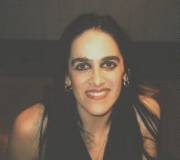
DIAMANDA
GALAS:
THE DARK
SIDE OF THE NEW MUSICS
By: Emma Dors.
Diamanda Galas: An enigmatic, defiant woman, a talented, versatile composer and artist, whose exceptional voice has such a wealth of nuances and registers not very often found in the world of the alternative musics, has been described by John Gill in "Time Out London" with these words: "Whore, saint, demon, lover, madwoman or angel, there is no other voice in rock, jazz or the avant-garde with her violence, consuming passion and pure elemental force." And it's true. Diamanda, "femme fatale", has such a vital energy that appears to be truly unquenchable no matter what, and she transfers all of it to each and everyone of her creations, her challenging public appearances and her shameless nerve, notwithstanding absolutely capable of being dead serious about certain issues in the different interviews she has agreed to throughout her career. She has been accused of being a blasphemous singer, she admits to her obsession with vampires, she is an active spokesperson for and defender of the seropositive collective, and her nonconformism as well as her wondrous inner strength have led her to explore all the possibilities of artistic expression fully committed to the cause of the outcast groups in our society, to express her rebellion against the status quo and her peculiar conception of art by means of a sinister, darkish atmosphere, rarely understood by the general audience.

Diamanda Galas (Photo: Tower Records © 1996)
GENESIS
Diamanda
Galas was born in San Diego, California, within a family
of a Greek origin. Diamanda has occasionally
visited her Greek relatives at Athens and Manati (near Sparta) -
she also has relatives in Smyrna, Katarsos, Egypt and Turkey -.
About her ancestral culture, the artist comments on its hard
nature, its renowned tradition of "vendettas", a
culture where the masculine power predominates, and it is
precisely this trait, the one she draws on in her performances.
Another trait typical of her ancestors she mentions is that of
materialism, one she does not possess, which is why her family do
not understand the gipsy-like lifestyle she so much favors,
always being on the move, engaging herself in world tours, not
saving her money for tomorrow.
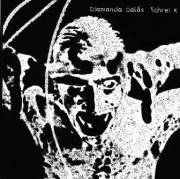 Her
father, a professor of Greek myth, used to play the bass and the
trombon at a jazz band, and it would be he the one to introduce
her to the music world, especially traditional Arab and Greek
music, aside from jazz, as she used to play with him. In those
times Diamanda used to play the piano, not to
sing, as her father always claimed that "Only idiots and
hookers are singers." This is why she would not study
opera till much later, given the absolute rejection her father
had towards opera singers most specially. Nevertheless, she did
have an extensive musical education. Thanks to her innate musical
skills, she would soon get a Master in Music, and at age fourteen
she becomes a member of the Symphonic Orchestra of San
Diego. Besides, she studies the performing arts at the University
of California. Soon her musical interests shift towards
blues and free jazz. From the classical piano she turns to
keyboards. However, it would still take her some time to discover
her voice. This happened in 1974, at a time when she was working
on things unconnected with music, when she was questioning
everything she had done before. She used to sing as she worked in
the street, together with a gang of transvestite friends at
Oakland, and it was then when she began to take an interest in
her vocal skills. Her first steps in this direction would take
her to Gospel, and later she moved on to a deeper exploration of
this vocal aspect of hers in several other fields. Galas
began her vocal career performing at mental hospitals and asylums
in San Diego between 1975 and 1977, but she left that activity
then as she does not consider herself to be a therapist.
Nonetheless, this experience would be very interesting for her.
It was then when she would develop her vocal technique, breaking
every established rule in music, using her voice as a fundamental
response of her body and soul to express herself as a human
being.
Her
father, a professor of Greek myth, used to play the bass and the
trombon at a jazz band, and it would be he the one to introduce
her to the music world, especially traditional Arab and Greek
music, aside from jazz, as she used to play with him. In those
times Diamanda used to play the piano, not to
sing, as her father always claimed that "Only idiots and
hookers are singers." This is why she would not study
opera till much later, given the absolute rejection her father
had towards opera singers most specially. Nevertheless, she did
have an extensive musical education. Thanks to her innate musical
skills, she would soon get a Master in Music, and at age fourteen
she becomes a member of the Symphonic Orchestra of San
Diego. Besides, she studies the performing arts at the University
of California. Soon her musical interests shift towards
blues and free jazz. From the classical piano she turns to
keyboards. However, it would still take her some time to discover
her voice. This happened in 1974, at a time when she was working
on things unconnected with music, when she was questioning
everything she had done before. She used to sing as she worked in
the street, together with a gang of transvestite friends at
Oakland, and it was then when she began to take an interest in
her vocal skills. Her first steps in this direction would take
her to Gospel, and later she moved on to a deeper exploration of
this vocal aspect of hers in several other fields. Galas
began her vocal career performing at mental hospitals and asylums
in San Diego between 1975 and 1977, but she left that activity
then as she does not consider herself to be a therapist.
Nonetheless, this experience would be very interesting for her.
It was then when she would develop her vocal technique, breaking
every established rule in music, using her voice as a fundamental
response of her body and soul to express herself as a human
being.
DIE-HARD ACTIVIST
When her brother Philip Dimitri
Galas (1954-1986), then already a famous playwright and
theater producer, is diagnosed with HIV, Diamanda
feels it very deep inside, since both of them are very close
indeed. He was a brilliant actor as well, whose work he financed
through Galas Exotic Cards, a business he had
started in San Francisco in 1978, and he had inspired his sister
in her teenage days. It was he the one to take her interests from
free jazz to cabaret music, to get an interest in the works by Nietzsche,
Antonin Artaud, Gerard Nerval Artaud, Gore Vidal, Baudelaire,
and Lautreamont, amongst others, and the one to
share with her a taste for Edgar Allan Poe. Such
readings would no doubt have a marked influence in her work.
Since 1983 Diamanda has undertaken a crusade to promote the cause of all those patients suffering from AIDs, and not just because of her brother's illness, as she herself claims, since already two years before Philip had been diagnosed the virus she had become a fervent activist in this field. Her true concern about this outcast collective is clearly, unmistakably reflected in her masterpiece, The Plague Mass, a controversial oratorio-indictment. Many people in the artistic circles pressured her against her project. Despite all these pressures, the artist continued to work in her original trilogy, The Masque of the Red Death, in London, and she did not care if they called her weird. Diamanda denies the charges that this work is but a piece of sentimental rubbish, according to, to her, some "misogynist idiots", who trivialize her message. Even if she is a seronegative woman, Diamanda has involved herself in the cause of the seropositive, not in an insincere way, but truly working side by side with them. She devotes her time to those patients of AIDs who have been abandoned by their families. She advocates tirelessly to achieve an adequate development of research into this illness as well as the legislative improvements to protect this collective. Nonetheless, she has occasionally been rejected by some of the affected, perhaps because of the aggressive attitude she has in her performances, in some occasions understood as a provocation rather than as an indictment. It is not strange, therefore, that her attitude has shocked even some of the seropositive. Yet Diamanda points out that her intention has never been therapeutical, but merely artistic. In spite of her personal concern in these issues, the terms must not be confused. This does not mean that her preoccupation about the people suffering from AIDs is not real and true.
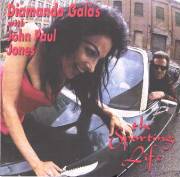 Certainly,
the people who are not infected with the virus will have
difficulty to truly comprehend what these who are affected will
ultimately feel deep inside, yet Diamanda
believes in the power of empathy, in the human capacity to
contribute to this collective. So she does not limit her interest
to the seropositive alone, but her sympathy extends to other
collectives. In her works the artist explores the world of
schizophrenia, aphasia, mental illnesses, visualizing such
behaviors as an almost rational response to situations of extreme
isolation, of an intolerable, even irrational nature, in terms of
a personal catharsis. Diamanda understands this
isolation, since she felt it herself in her childhood, and even
today she consciously often looks for loneliness for herself.
After having been affected with Hepatitis C for about four years,
she also understands the despondency affecting any collective of
sick people, be it AIDs, hepatitis, certain types of cancer or
any other illness having no cure today, and she denounces the
tendency of the medical class to refuse a cooperation with their
patients to find adequate treatments, or their reluctance to
admit to their ignorance with respect to these. To her, the most
dangerous thing with respect to the AIDs epidemic is the way we
are conditioned to think of this illness, as if it were something
that inescapably leads to death. She thinks that treatments with
alpha-interferon and/or placebo drugs are absolutely wrong and
inadequate, when what the doctors should do is work together with
their patients and try to find the way to stimulate the immune
system by means of combined therapies, even experimental ones,
instead of rejecting such initiatives, not to mention alternative
therapies, so that if one is diagnosed some of these viruses, the
only thing left for the patient to do is prepare for their
funeral. What annoys her most is the attitude society has before
such epidemics as that of AIDs, as given the fear of contagion,
it isolates and outcasts a whole collective, cowardly
trivializing what should affect each and every one of us. To her,
such an attitude is but a sign of a social mental disorder,
typical of those who understand the world in a simplistic,
childish way. The misinformation that causes such an isolation
and confusion is likewise found in the research in the field of
mental illnesses, and both the AIDs patients and those suffering
from mental disorders are powerless, outcast from society; and
should they comment anything on their illnesses, they immediately
become suspect, if not undesirable.
Certainly,
the people who are not infected with the virus will have
difficulty to truly comprehend what these who are affected will
ultimately feel deep inside, yet Diamanda
believes in the power of empathy, in the human capacity to
contribute to this collective. So she does not limit her interest
to the seropositive alone, but her sympathy extends to other
collectives. In her works the artist explores the world of
schizophrenia, aphasia, mental illnesses, visualizing such
behaviors as an almost rational response to situations of extreme
isolation, of an intolerable, even irrational nature, in terms of
a personal catharsis. Diamanda understands this
isolation, since she felt it herself in her childhood, and even
today she consciously often looks for loneliness for herself.
After having been affected with Hepatitis C for about four years,
she also understands the despondency affecting any collective of
sick people, be it AIDs, hepatitis, certain types of cancer or
any other illness having no cure today, and she denounces the
tendency of the medical class to refuse a cooperation with their
patients to find adequate treatments, or their reluctance to
admit to their ignorance with respect to these. To her, the most
dangerous thing with respect to the AIDs epidemic is the way we
are conditioned to think of this illness, as if it were something
that inescapably leads to death. She thinks that treatments with
alpha-interferon and/or placebo drugs are absolutely wrong and
inadequate, when what the doctors should do is work together with
their patients and try to find the way to stimulate the immune
system by means of combined therapies, even experimental ones,
instead of rejecting such initiatives, not to mention alternative
therapies, so that if one is diagnosed some of these viruses, the
only thing left for the patient to do is prepare for their
funeral. What annoys her most is the attitude society has before
such epidemics as that of AIDs, as given the fear of contagion,
it isolates and outcasts a whole collective, cowardly
trivializing what should affect each and every one of us. To her,
such an attitude is but a sign of a social mental disorder,
typical of those who understand the world in a simplistic,
childish way. The misinformation that causes such an isolation
and confusion is likewise found in the research in the field of
mental illnesses, and both the AIDs patients and those suffering
from mental disorders are powerless, outcast from society; and
should they comment anything on their illnesses, they immediately
become suspect, if not undesirable.
THE DARK SIDE OF THE ARTS
Besides representing the
seropositive and the mentally sick, Diamanda
also denounces the situations leading many innocent people to
death. Separation and death are themes she explores in her works
with the same passion she has explored other situations since she
began her career. In her second work, simply called Diamanda
Galas, released in 1984 under the label Metalanguage
Records, there only appear two pieces, the first one of
which is "Tragouthia apo to Aima Exoun Fonos"
("Canticle for the Blood of the Assassinated
Prisoners"): This anguished piece deals with the political
prisoners tortured and brutally killed by the Greek Junta; and
the second piece, "Panoptikon", ("Many
Eyes"), reflect models of claustrophobia and paranoia. Her
work is always related to a person in a situation of forced
isolation, be it imposed from without or from within, from the
biochemical or the social perspective, whether it be caused by
schizophrenia or not. A greater part of her work is centered om
this dark side of the person. As she claims, the fact that we
become aware of this dark side of the psyche allows us to face
the difficulties and the sorrows of life. For instance, in his
last two years of life, her brother Philip,
instead of chickening out and giving up the struggle, worked very
hard to see his work completed, with the illusion that it was to
survive him.
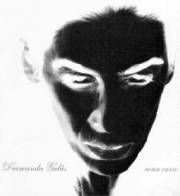 In
her work Insekta, the artist deals with the issue of
isolation once again, with a vocal treatment that reveals the
viewpoint from both sides of the cage of the forced isolation of
the individual. In her performance at the Lincoln Center,
the cage hangs from the ceiling. This is a tortured piece on the
treatment suffered by certain anonymous communities, such as the
people who have been caged within mental institutions, whose
relatives cannot or will not save them. Insekta gives
her voice to the situations in which the patients are raped
and/or beaten in the middle of the night. For these people, the
only freedom they can enjoy is that of their thoughts.
In
her work Insekta, the artist deals with the issue of
isolation once again, with a vocal treatment that reveals the
viewpoint from both sides of the cage of the forced isolation of
the individual. In her performance at the Lincoln Center,
the cage hangs from the ceiling. This is a tortured piece on the
treatment suffered by certain anonymous communities, such as the
people who have been caged within mental institutions, whose
relatives cannot or will not save them. Insekta gives
her voice to the situations in which the patients are raped
and/or beaten in the middle of the night. For these people, the
only freedom they can enjoy is that of their thoughts.
In Vena Cava, the artist deals yet once more with a person in a situation of absolute alienation, in some sort of solitary confinement. In it the vocalizations become more subtle than they are in her trilogy, the text reflects a greater introverted character, and the voice portrays a greater dose of awareness, one of a more internalized nature than in the Plague Mass. This work, also considered to be of a satanic nature by some, meant that Diamanda Galas had her work vetoed by the Church as well as on the part of some groups in favour of euthanasia in the tape version of Final Exit, so she could not include all the material she had prepared for Vena Cava the way she had wished to do.
ONE VOICE, A MYRIAD OF GENRES
Diamanda
has not limited herself to an only musical genre, but has
explored all of them: she has sung Puertorican music, Salsa,
Cuban music, blues, and even flamenco. Her strength on the stage
as well as her versatile work in the musical aspects of her
performances have attracted the attention of such composers as Pierre
Boulez, Iannis Xenakis and Vinko Globokar,
to name but a few. The latter invites her to collaborate in his
work Un jour comme un autre. Diamanda
also collaborates with Test Department, Einsturzende
Neubaten, Nick Cave, D. Thomas, and Henry,
among many others.
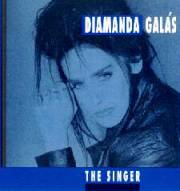 Likewise,
she has performed in punk clubs such as Club Lingerie
in Los Angeles, as well as at other clubs, like I-beam,
Club Nine and Danceteria in New York
City. Few artists can claim to such a wide range of activities.
Her introduction in the world of the new musics came to happen
through her own improvisations, although she also admits to the
influence that John Coltrane had in her work.
Likewise,
she has performed in punk clubs such as Club Lingerie
in Los Angeles, as well as at other clubs, like I-beam,
Club Nine and Danceteria in New York
City. Few artists can claim to such a wide range of activities.
Her introduction in the world of the new musics came to happen
through her own improvisations, although she also admits to the
influence that John Coltrane had in her work.
In the development of her voice Diamanda also admits to having received a certain influence by Cecil Taylor, Sun Ra, or Artaud, although, to her, such influences are marginal at best. Despite the fact that she has her Master in Music as stated before, Galas used to think of herself as some sort of outcast from the usual academicist levels, which is why she ended up abandoning the academic institution, as she felt that this would not allow her to develop her creativity as freely as she wished. The artist works very hard indeed to develop her voice, comparable to that of Meredith Monk, Joan LaBarbara, María Callas or Fatima Miranda, not to mention Cathy Berberian, a virtuoso of avantgarde voice, whose vocal experiments would inspire Diamanda. Yet, at the same time, Galas surpasses such virtuosity as she develops new vocal techniques of her own, in which she builds up vocal groups or episodes adding musical meaning to the whole, either in the form of short movements or in an uninterrupted flow of strikingly pure voice, also improvising new vocal effects, always in an innovative way, never adapting to the reiterative vocal traditions of the classical method for the production of conventional themes, nor does she conform to the minimalist techniques so typical of Philip Glass, or to the modular method also developed by Steve Reich, so that the artist appears to be emphasizing vocal discontinuity instead of vocal continuity. Furthermore, her treatment of the oral text or speech in her compositions follows an irregular pattern in which the text comes to be disintegrated, in a distorting way, so that language is not so much a vehicle to transmit any coherent information per se, but rather a sonic presence which turns out to be cryptic, powerful, mysterious, where the emphasis between what is purely musical and what is speech keeps shifting its focus, resulting in a sort of sonic collage whose aural meaning is innovative, shapechanging, and all that comes out synthesized in a series of subtle metamorphoses which vary with each performance.
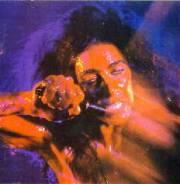 Diamanda
has been working for long years with her teacher of bel canto, Frank
Kelly, and she has been able to reach up to three and a
half octaves with absolute ease. Her understanding of the
electronic medium allows her to control her performance at all
times. To her, the stage is holy ground, and this fact requires
of her to give the best of herself in each occasion. This is why
she usually takes care of the staging of each one of her
performances even to the minutest of details, as is the lighting,
the technical aspects of the electronics, the tapes, in a word,
everyhting. She likes to control each and every one of the
elements involved in a performance so as to guarantee the best
professionality she can afford. Diamanda
believes that a live performance is not the time to experiment or
look for a catharsis, but a sacrifice and a rendering of her art
that requires a very accurate preparedness. Her works reflect a
sinister atmosphere, devilish, dark, disquieting. In her wish to
explore all musical fields, she produces performances in which
she includes dismal staging atmospheres, disturbing electronic
sounds, sometimes inspired by a somber romanticism of an almost
hypnotic nature that transmits pain, anguish, terror,
powerlessness or despair. Her works include the use of different
languages, such as English, French, her native Greek or Italian,
and she even comes to create her own languages by means of
utilizing complicated onomatopoeias and distorted pitch. This
latter aspect can be seen in her performances in the world of
terror movies, the most remarkable of which is the Drácula
by Coppola, where she impersonates one of the
brides of the vampire, at the same time as her voice participates
of the original soundtrack, contributing to the terrorific
atmosphere in her particular rendering of voices from beyond the
grave. Galas has always been fascinated by the
vampire theme, yet not even herself knows the reason why she
feels so much fascination on it. One of the vampires that has
most inspired her, for instance, to perform her role in this
movie, was precisely the character of the Countess
Bathory, a well-known lesbian vampire who, at age five
hundred, used to seduce young virgins so as to rejuvenate herself
by drinking their blood.
Diamanda
has been working for long years with her teacher of bel canto, Frank
Kelly, and she has been able to reach up to three and a
half octaves with absolute ease. Her understanding of the
electronic medium allows her to control her performance at all
times. To her, the stage is holy ground, and this fact requires
of her to give the best of herself in each occasion. This is why
she usually takes care of the staging of each one of her
performances even to the minutest of details, as is the lighting,
the technical aspects of the electronics, the tapes, in a word,
everyhting. She likes to control each and every one of the
elements involved in a performance so as to guarantee the best
professionality she can afford. Diamanda
believes that a live performance is not the time to experiment or
look for a catharsis, but a sacrifice and a rendering of her art
that requires a very accurate preparedness. Her works reflect a
sinister atmosphere, devilish, dark, disquieting. In her wish to
explore all musical fields, she produces performances in which
she includes dismal staging atmospheres, disturbing electronic
sounds, sometimes inspired by a somber romanticism of an almost
hypnotic nature that transmits pain, anguish, terror,
powerlessness or despair. Her works include the use of different
languages, such as English, French, her native Greek or Italian,
and she even comes to create her own languages by means of
utilizing complicated onomatopoeias and distorted pitch. This
latter aspect can be seen in her performances in the world of
terror movies, the most remarkable of which is the Drácula
by Coppola, where she impersonates one of the
brides of the vampire, at the same time as her voice participates
of the original soundtrack, contributing to the terrorific
atmosphere in her particular rendering of voices from beyond the
grave. Galas has always been fascinated by the
vampire theme, yet not even herself knows the reason why she
feels so much fascination on it. One of the vampires that has
most inspired her, for instance, to perform her role in this
movie, was precisely the character of the Countess
Bathory, a well-known lesbian vampire who, at age five
hundred, used to seduce young virgins so as to rejuvenate herself
by drinking their blood.
CINEMATIC SCORES
With respect to the way Galas
writes her music, the artist explains that her scores are more
like cinema notes. Although she did not receive an adequate
education in composition, she is perfectly able to read a score,
and she dislikes the musicians who claim they don't. Even if she
is not quite able to write music, as she centered her skills in
experimental performance, and especially, given the circumstance
that what she does truly is so weird, so quickly changeable, she
believes that it would be very difficult to write her creations
making use of conventional musical notation. In some occasions
she has done so for certain people, yet she does not think of it
as being essential. She prefers to write her music her own way,
noting modulation and spatial manipulation, the timbre she uses
at each stage, the linguistic aspect to develop at each
modulation, the pitch and range of these, some symbols to note
vocal links, silences, pauses, reverberation, even lighting for
each performance, the electronics, everything, rather as if it
were a theatre play or a movie script and not a traditional
musical score at all. Her peculiar way to understand musical
notation is cinematic, closer to poetry, and includes every vocal
aspect, every gesture, every technical and dramatic nuance that
her complex stagings require.
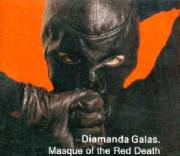 Diamanda
views herself as some sort of an electroacoustic actress or
performer, since she utilizes her voice with four of five
microphones, two delay units, sometimes two harmonizers,
selective stereo equalization for certain parts, etc. That is,
her voice becomes thus a new instrument that belongs into an
electronic whole. In such a way that it no longer is a mere voice
sounding with electronic instruments but it truly becomes
electronic voice in a literal way. Diamanda Galas
emphasizes the distinction between the acoustic and the
electronic qualities of her voice. To her, the three and a half
octaves in the vocal register she has so long struggled to
achieve, are the acoustic part of her repertoire, whereas the
electroacoustic part is the interface she establishes between the
possibilities offered by the human voice, the strange sound
effects the electronic medium offers in the manipulation of this
voice by means of delay lines, and the digital or analogic
processing of each signal. Diamanda explains an
example of this process in the production of any vocal sound
which is then processed with a delay of, for instance, 250
milliseconds which turns this sound into a chorus, in which the
new instrument is vocally produced, turning the whole room into
an instrument at the same time, since the resonance of this voice
changes with the use of the entire equipment, as the electronic
support creates a new sound. The difference would be equivalent
to that existing between an acoustic and an electronic guitar. In
her particular version, her "guitar" are her vocal
cords, and it is not that easy to achieve such effects with her
voice precisely because of that fact.
Diamanda
views herself as some sort of an electroacoustic actress or
performer, since she utilizes her voice with four of five
microphones, two delay units, sometimes two harmonizers,
selective stereo equalization for certain parts, etc. That is,
her voice becomes thus a new instrument that belongs into an
electronic whole. In such a way that it no longer is a mere voice
sounding with electronic instruments but it truly becomes
electronic voice in a literal way. Diamanda Galas
emphasizes the distinction between the acoustic and the
electronic qualities of her voice. To her, the three and a half
octaves in the vocal register she has so long struggled to
achieve, are the acoustic part of her repertoire, whereas the
electroacoustic part is the interface she establishes between the
possibilities offered by the human voice, the strange sound
effects the electronic medium offers in the manipulation of this
voice by means of delay lines, and the digital or analogic
processing of each signal. Diamanda explains an
example of this process in the production of any vocal sound
which is then processed with a delay of, for instance, 250
milliseconds which turns this sound into a chorus, in which the
new instrument is vocally produced, turning the whole room into
an instrument at the same time, since the resonance of this voice
changes with the use of the entire equipment, as the electronic
support creates a new sound. The difference would be equivalent
to that existing between an acoustic and an electronic guitar. In
her particular version, her "guitar" are her vocal
cords, and it is not that easy to achieve such effects with her
voice precisely because of that fact.
CONTROVERSIAL ALBUMS
Diamanda's
recording production is as eclectic as her spectacular live
performances. Her first record, released in 1982, was Litanies
of Satan, a work where Dave Hunt
collaborates, one of whose compositions is an adaptation of one
of Charles Baudelaire's works, the Poems of
the Revolt, specifically his poem Les Litanies de Satan,
dedicated to those who because of the opression on the part of
the government are condemned to isolation and social alienation.
This album also includes tape, electronic manipulation and voice.
The second and last theme, "Wild women with Steak
Knives", expresses nasty human relationships and mean souls,
with her resourceful voice. Diamanda comments
that because of this recording, her concerts were cancelled due
to the social pressure of different morality groups. No doubt,
this album would contribute to her being considered a satanist, a
blasphemous, ungodly outcast. About her second recording, Diamanda
Galas (1984), we have already talked.
Another work by this charismatic, controversial artist, is for instance, The Singer, a work where her vocals skills turn to old blues songs, written by Willie Dixon, M. Bloomfleid, Jay Hawkins and Roy Acuff. In this album Diamanda also includes a number of more or less traditional arrangements she made herself, accompanied by her piano or Hammond organ. Only the last theme, "Judgement Day", was written by Galas. Les Yeux Sans Sang is another work composed by this artist, which she developed based on her previous work at Wild Women With Steak Knives, and which premiered in 1984 at the New York Philarmonic's Horizon's Festival.
THE "PLAGUE MASS"
But it is no doubt her trilogy The
Masque of the Red Death, referred to in a generic way as the
Plague Mass, her most important work. The Plague
Mass, as stated before, is some sort of oratorio in which,
as explained in the New York Times, the author
denounces the people who consider AIDs as "divine
retribution", and the Observer claims
this is "the most profound musical contribution yet made
to the support of the AIDS community". In this work the
author expresses her ideas through an individual who becomes the
spokesperson for the groups of outcast people, many of whom can
no longer speak for themselves, in the context of society.
Likewise, it involves the individual who opposes other social
groups. In the Plague Mass the texts are recited rather
than sung. Diamanda utilizes here the Biblical Psalms
as well as the Book of Leviticus, the texts of the Law
of Moses in which the procedures to declare a
quarantine must be followed according to the ancient traditions,
in the terms that the priests usually refer to homosexuality, as
well as the rituals to ask God for protection. For instance, in
Psalm 88, the ritual begins with the phrases: "O Lord
God of my salvation, I have cried day and night before thee...
incline thy ear unto my cry." In fact, The Masque
Of The Red Death, directly inspired on Poe's
writings, although containing many other sources as well, and
related to a number of convictions and ways of thinking, consists
of three different albums, to which a fourth part would later be
added, each one of which reflects a different perspective of the
crisis of AIDs. This trilogy plus its conclusion constitute the Mass
of the Plague, a musical documentary of the epidemic in our
present days. The first part of this saga was to be premiered at
the Ars Electronica Festival in 1986, a
performance which took place at the Linz Shipyards in Austria,
that in fact turned out to be an ideal location for such an
ambitious work, in which the author herself performed each and
every one of the instruments used, plus the pre-recorded voices
and her live voice as well.
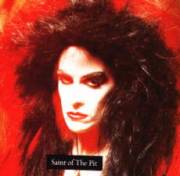 This
first part was The Divine Punishment, dedicated to Tom
Hopkins (who died in 1985). It is based on texts from
the Old Testament, and includes two pieces in the style
of classical suites: "Deliver Me from Mine Enemies" is
a track in which the voices denounce the plague in a pulsating
way, while at the same time a nebulous order, "This Is The
Law of the Plague", contributes to creating a terrible,
ominous atmosphere: "And the priest shall look upon the
plague for a rising, and for a scab, and for a bright spot. And
the priest shall shut up he that hath the plague. He shall carry
them forth to a place unclean. He shall separate them in their
uncleanness. This is the law of the plague: To teach when it is
clean and when it is unclean..." Next, the victim
claims with the words of Psalms 59, 22 and 88: "Why hast
Thou forsaken me?", just as Jesus Christ
had done later, on the Cross, at his dying moments; continuing
with the prayer, "Deliver me from my enemies, oh my God",
and ending with the anguished question: "Shalt Thou show
wonders to the dead?", a mournful imprecation of the
condemned. At the same time the listener hears suffocating
onomatopoeias, echoes of the ancient Greek legends, tortured fits
of rage, voices seemingly coming from will'o'the'wisps, screeches
as if they were caused by creaky doors achieved in a vocal way,
terrifying sounds that resemble those of creeping creatures
coming up to the surface from a dreadful abyss... Diamanda
defines this album as a geography of the plague mentality. To her
it is the accursed voices of the accusers the ones to condemn the
victims of the plague as "unclean". In this segment the
artist recites parts of the Leviticus, especially a text
that passes judgement on the afflicted ones without compassion.
The God of the Old Testament does not
offer redemption or salvation whatsoever. The Plague is the
Divine Punishment, as it is understood by those who defend such
views nowadays, the modern day evangelists and moralists. Diamanda
claims that the God of these homophobic accusers is a malignant,
treacherous God, and in this sense the actress stands against
him, siding with those who rebel against such a cruel God. If
this means that she is siding with Satan, so what? Taking Milton's
point of view in Paradise Lost, she subscribes to the
idea that it is "better to rule in Hell than to serve in
Heaven". Naturally enough, such ideas had her, once
again, called a blasphemous satanist, a witch. Galas
is proud of this, since witches were but people who had rejected
to side up with the religious powers of their times, having been
executed for independent thought. In this album, with the second
suite, "Free among the Dead", a piece with complex
vocal stretchings, as well as blues-like inflections, Diamanda
turns around this old vengeful God and recites texts of the Psalms
and the Lamentations to an emerging God, this time of a
more compassionate nature: "Deliver me from mine
enemies, oh my God. The mighty are gathered against me".
This fragment makes it clear that the author is not to be
considered a satanist, since the fact that she rebelled against
the God of the accusers does not imply such a thing. Jesus
Christ himself, she points out, rebelled against the old
order. The conclusion, "Sono L'Antichristo," is a truly
shocking piece written by Galas herself. In it
the condemned embraces all the damning epithets and throws them
into the faces of the judges: "I am the Scourge. I am
the Holy Fool. I am the Shit of God. I am the Sign. I am the
Plague. I am the Antichrist." Sung in Italian, the way Diamanda
sings this Letany, the word for the plague (pestilenza) has a
stronger semantic charge than in English. The organ sounds louder
and louder, in a cacophonic crescendo that incorporates sounds
resembling those of a rattlesnake, and the voice of the artist
makes the listener's hairs stand on end. The listener experiences
then pure nerve, such an affliction and a defiance that reach
deep into the furthest recesses of the very soul, in a
disturbing, terrifying atmosphere, despairing, apocalyptic,
horrible. This work merited the award it was given at the Ars
Electronica Festival held in Linz, Austria, in 1986.
This
first part was The Divine Punishment, dedicated to Tom
Hopkins (who died in 1985). It is based on texts from
the Old Testament, and includes two pieces in the style
of classical suites: "Deliver Me from Mine Enemies" is
a track in which the voices denounce the plague in a pulsating
way, while at the same time a nebulous order, "This Is The
Law of the Plague", contributes to creating a terrible,
ominous atmosphere: "And the priest shall look upon the
plague for a rising, and for a scab, and for a bright spot. And
the priest shall shut up he that hath the plague. He shall carry
them forth to a place unclean. He shall separate them in their
uncleanness. This is the law of the plague: To teach when it is
clean and when it is unclean..." Next, the victim
claims with the words of Psalms 59, 22 and 88: "Why hast
Thou forsaken me?", just as Jesus Christ
had done later, on the Cross, at his dying moments; continuing
with the prayer, "Deliver me from my enemies, oh my God",
and ending with the anguished question: "Shalt Thou show
wonders to the dead?", a mournful imprecation of the
condemned. At the same time the listener hears suffocating
onomatopoeias, echoes of the ancient Greek legends, tortured fits
of rage, voices seemingly coming from will'o'the'wisps, screeches
as if they were caused by creaky doors achieved in a vocal way,
terrifying sounds that resemble those of creeping creatures
coming up to the surface from a dreadful abyss... Diamanda
defines this album as a geography of the plague mentality. To her
it is the accursed voices of the accusers the ones to condemn the
victims of the plague as "unclean". In this segment the
artist recites parts of the Leviticus, especially a text
that passes judgement on the afflicted ones without compassion.
The God of the Old Testament does not
offer redemption or salvation whatsoever. The Plague is the
Divine Punishment, as it is understood by those who defend such
views nowadays, the modern day evangelists and moralists. Diamanda
claims that the God of these homophobic accusers is a malignant,
treacherous God, and in this sense the actress stands against
him, siding with those who rebel against such a cruel God. If
this means that she is siding with Satan, so what? Taking Milton's
point of view in Paradise Lost, she subscribes to the
idea that it is "better to rule in Hell than to serve in
Heaven". Naturally enough, such ideas had her, once
again, called a blasphemous satanist, a witch. Galas
is proud of this, since witches were but people who had rejected
to side up with the religious powers of their times, having been
executed for independent thought. In this album, with the second
suite, "Free among the Dead", a piece with complex
vocal stretchings, as well as blues-like inflections, Diamanda
turns around this old vengeful God and recites texts of the Psalms
and the Lamentations to an emerging God, this time of a
more compassionate nature: "Deliver me from mine
enemies, oh my God. The mighty are gathered against me".
This fragment makes it clear that the author is not to be
considered a satanist, since the fact that she rebelled against
the God of the accusers does not imply such a thing. Jesus
Christ himself, she points out, rebelled against the old
order. The conclusion, "Sono L'Antichristo," is a truly
shocking piece written by Galas herself. In it
the condemned embraces all the damning epithets and throws them
into the faces of the judges: "I am the Scourge. I am
the Holy Fool. I am the Shit of God. I am the Sign. I am the
Plague. I am the Antichrist." Sung in Italian, the way Diamanda
sings this Letany, the word for the plague (pestilenza) has a
stronger semantic charge than in English. The organ sounds louder
and louder, in a cacophonic crescendo that incorporates sounds
resembling those of a rattlesnake, and the voice of the artist
makes the listener's hairs stand on end. The listener experiences
then pure nerve, such an affliction and a defiance that reach
deep into the furthest recesses of the very soul, in a
disturbing, terrifying atmosphere, despairing, apocalyptic,
horrible. This work merited the award it was given at the Ars
Electronica Festival held in Linz, Austria, in 1986.
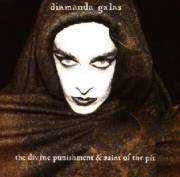 In
the second part of this complex trilogy, Saint Of The Pit
(1986), Diamanda speaks for those who, like Jesus
Christ, were crucified because of their beliefs. The
artist gives her voice to those who are afflicted with this slow,
agonizing death. Together with her own texts, she includes others
she takes from the French symbolist school, from poets of the
nineteenth century, such as Baudelaire, Corbiere
and Nerval, to the insidious, insistent rhythm
of Gregorian chants. The inclusion of these poems could respond
to a sentimental need on the part of the artist, since she
explains that her brother gave her his favourite book of French
poetry in his deathbed. To Diamanda there is no
better homage to his memory, as well as to that of those who have
suffered the same kind of martyrdom, than to include these poems
within her work. Actually, Diamanda sees the
victims of the AIDs plague as present day saints who have been
abandoned by a cruel, compassionless society. The album shifts
from the outer viewpoint of the community to the inner one, the
state of mind of the victim. The work opens with an ominous
introduction, "La Treiziemen Revient," a solo played on
a Hammond organ. In this moment a spiritual transformation takes
place, one in which pain cleanses the soul, this fact being
reflected in an archetypical octave, where the intense, powerless
rage of the afflicted gets gradually weakened. This piece is
followed by "Deliver Me," a vibrant solo that resembles
a moan typical of the Middle Eastern countries, as anguished as
to move the listener deep within the soul. The wails of the
singer resemble burning arrows aiming for the deepest recesses of
the very essence of the human being. The last section of this
part, sung in French, is a poem by Baudelaire, Self-Tormentor,
which begins: "No rage, no rancor: I shall beat you as
butchers fell on ax. As Moses smote the rock in Horeb -- I shall
make you weep". The end is no less expressive: "I
am the vampire at my own veins, one of the great lost horde
doomed for the rest of time, and beyond, "to laugh -- but
smile no more"". The second part of this album
begins with a Greek theme, as a homage to her brother, where the
singer explores her inner self, meditates on her situation, and
reflects a deep feeling of sadness. This theme,
"L'heautontimoroumenos", contains suggestive voices of
a darkly erotic nature and returns to Baudelaire's
poem, this time adapted with crazed modulations in a surreal
dialogue between children and witches, at the same time pointing
to an archetypical response: the nobility of accepting one's own
fate, even from the pit of suffering. Then, the artist gives us a
traditional operatic version of Nerval's poem, Artemis,
with which she develops tortured metaphors, where the soul
self-evaluates and reaches up to renunciation, and even to
excommunication. The theme is concluded with Corbiere's
poem, Cris D'Aveugle ("The Cry of the Blind
Man"), where a sustained wail that reminds the listener of
the screeches of bats, slowly gives way to a cacophony of voices
which drowns the "Deus Misericors" sung by the choir:
we can hear the creaky voice of an old person, an innocent,
childish whispering voice, hardly audible muttering sounds mixed
with creaking sounds, arias that sound now from nearby, now from
very far away, squeals and growls, unearthly rustling sounds
reminding of the air escaping from an inflated but punctured
wheel or perhaps a balloon, agonizing sighs... It looks as if all
the monsters of a hellish abyss had suddenly acquired a voice of
their own. When the listener is brought to the limit of
resistance, a pause is produced and the final text is heard:
"Pardon for praying hard, Lord, if it is fate, My eyes
two burning holy water fonts, The devil has but his fingers
inside, Pardon for crying loud, Lord, against fate; I hear the
north wind which bugles like a horn. It is the hunting call for
the kill of the dead. I bay enough on my own, I hear the north
wind, I hear the horn's knell..."
In
the second part of this complex trilogy, Saint Of The Pit
(1986), Diamanda speaks for those who, like Jesus
Christ, were crucified because of their beliefs. The
artist gives her voice to those who are afflicted with this slow,
agonizing death. Together with her own texts, she includes others
she takes from the French symbolist school, from poets of the
nineteenth century, such as Baudelaire, Corbiere
and Nerval, to the insidious, insistent rhythm
of Gregorian chants. The inclusion of these poems could respond
to a sentimental need on the part of the artist, since she
explains that her brother gave her his favourite book of French
poetry in his deathbed. To Diamanda there is no
better homage to his memory, as well as to that of those who have
suffered the same kind of martyrdom, than to include these poems
within her work. Actually, Diamanda sees the
victims of the AIDs plague as present day saints who have been
abandoned by a cruel, compassionless society. The album shifts
from the outer viewpoint of the community to the inner one, the
state of mind of the victim. The work opens with an ominous
introduction, "La Treiziemen Revient," a solo played on
a Hammond organ. In this moment a spiritual transformation takes
place, one in which pain cleanses the soul, this fact being
reflected in an archetypical octave, where the intense, powerless
rage of the afflicted gets gradually weakened. This piece is
followed by "Deliver Me," a vibrant solo that resembles
a moan typical of the Middle Eastern countries, as anguished as
to move the listener deep within the soul. The wails of the
singer resemble burning arrows aiming for the deepest recesses of
the very essence of the human being. The last section of this
part, sung in French, is a poem by Baudelaire, Self-Tormentor,
which begins: "No rage, no rancor: I shall beat you as
butchers fell on ax. As Moses smote the rock in Horeb -- I shall
make you weep". The end is no less expressive: "I
am the vampire at my own veins, one of the great lost horde
doomed for the rest of time, and beyond, "to laugh -- but
smile no more"". The second part of this album
begins with a Greek theme, as a homage to her brother, where the
singer explores her inner self, meditates on her situation, and
reflects a deep feeling of sadness. This theme,
"L'heautontimoroumenos", contains suggestive voices of
a darkly erotic nature and returns to Baudelaire's
poem, this time adapted with crazed modulations in a surreal
dialogue between children and witches, at the same time pointing
to an archetypical response: the nobility of accepting one's own
fate, even from the pit of suffering. Then, the artist gives us a
traditional operatic version of Nerval's poem, Artemis,
with which she develops tortured metaphors, where the soul
self-evaluates and reaches up to renunciation, and even to
excommunication. The theme is concluded with Corbiere's
poem, Cris D'Aveugle ("The Cry of the Blind
Man"), where a sustained wail that reminds the listener of
the screeches of bats, slowly gives way to a cacophony of voices
which drowns the "Deus Misericors" sung by the choir:
we can hear the creaky voice of an old person, an innocent,
childish whispering voice, hardly audible muttering sounds mixed
with creaking sounds, arias that sound now from nearby, now from
very far away, squeals and growls, unearthly rustling sounds
reminding of the air escaping from an inflated but punctured
wheel or perhaps a balloon, agonizing sighs... It looks as if all
the monsters of a hellish abyss had suddenly acquired a voice of
their own. When the listener is brought to the limit of
resistance, a pause is produced and the final text is heard:
"Pardon for praying hard, Lord, if it is fate, My eyes
two burning holy water fonts, The devil has but his fingers
inside, Pardon for crying loud, Lord, against fate; I hear the
north wind which bugles like a horn. It is the hunting call for
the kill of the dead. I bay enough on my own, I hear the north
wind, I hear the horn's knell..."
The third part of this trilogy uses the music of Swing Low Sweet Chariot to introduce a bloodcurling call as confronted to a stalking death. Likewise, we can hear a fragment of the Glory Mass in the piece "Double-Barrel Prayer", whose aggressive rhythm transforms this work into a strangely avant-garde mass, full of life and challenging. Two additional psalms are included, the gospel-blues "Let Me People Go" and "The Lord Is My Shepherd", in whose rendering the voice of the artist acquires a sickly quality, disturbing, agonizing, as if it were at the limit of its strength. With "You Must be Certain of the Devil", Diamanda abruptly ends up with her solemn lamentations and issues a furious call to arms, so that the condemned defend themselves. "Direct action is essential," states the artist, "it's to kill or be killed. I know it's not `politically correct' to advocate the use of guns, but we're talking about survival." On the cover of this record we can see her with a .38 special. Now Satan has become the enemy. And this time the Devil is impersonated by those pious Christians and homophobic government officials whose policies with respect to AIDs have declared war on the homosexual community. Diamanda resorts to her Greek heritage, namely the Spartan tradition according to which women turn their mourning into an oath of vengeance for their dead, their knives at their hands. True, the text is no doubt far more warlike than any texts before, yet from a musical point of view this album is the most accessible one of the three, perhaps because it has a more rhythmic character, and it also portrays a more sarcastic, more critical aspect of Diamanda's.
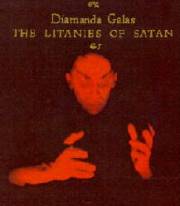 Later
Diamanda adds a new part to the Plague Mass,
called There Are No More Tickets to the Funeral. The
final version of the Plague Mass premiered on October
12th and 13th, 1990, at the impressive cathedral of St.
John the Divine, in Manhattan, New York. According to Diamanda
Galas it was an authentic "Missa solemnis" (a
solemn mass) for the disinherited, at a church that proved what
true compassion is. Such an event was certainly recorded, and the
music has been released under the label Mute Records.
As usual, the artist makes extensive use of her wide range of
musical resources as well as her acute intelligence. Her piano
background is evident, and her vocal skills, which have nothing
to envy from the best opera singers all over the world, turn her
performance into something to be remembered. Furthermore, given
its contents, just like any other of her former performances,
this Mass is a slap on the face of society at large,
given its controversial criticism and its undeniable charge that
denounces what is obvious. No matter what pressures she received
to hush her project, or at the very least to tone it down, Diamanda
fearlessly calls things by their name. Which has once more
incensed the morality groups against her, accusing her of
outrageous blasphemy, most especially when this work was
performed in Italy, near Florence. Since several parts of the Mass
are sung in Italian, it was perceived by the Italians as a
sacrilegious mass. Even though her supporters cheered her, mostly
aware of the work and its meaning thanks to an article appeared
at a gay zine (Babilonia), the representatives of the
Town Hall who had attended the premiere felt outraged at such
impudence as the actress had in presenting her blasphemous work.
The bourgeois community was deeply offended, and the media called
her "Voice, Sex and Sacrilege", with such
headlines as "Furious Controversy Surrounds "the
Accursed" Artist"; "Diamanda, to Hell and
Back", etc. The Christian Democratic Party
politicians were truly infuriated, and for weeks blamed her
satanic insult to all that is sacred, her affront to the
community and to morality. The actresss had never intended to
offend the Italian society, however. She was hurt to see how her
true aims had been misinterpreted so thoroughly. At the very
least she had hoped it would be merely tolerated within the
context of her being famous as a respectable avant-garde artist
and performer. Yet those who had taken her to Italy and
introduced her there had to suffer the aftermath of the scandal.
She did not find this out till much later, as at that moment she
had left for another country soon after her performance in Italy,
since she had been engaged in a world tour at the time.
Later
Diamanda adds a new part to the Plague Mass,
called There Are No More Tickets to the Funeral. The
final version of the Plague Mass premiered on October
12th and 13th, 1990, at the impressive cathedral of St.
John the Divine, in Manhattan, New York. According to Diamanda
Galas it was an authentic "Missa solemnis" (a
solemn mass) for the disinherited, at a church that proved what
true compassion is. Such an event was certainly recorded, and the
music has been released under the label Mute Records.
As usual, the artist makes extensive use of her wide range of
musical resources as well as her acute intelligence. Her piano
background is evident, and her vocal skills, which have nothing
to envy from the best opera singers all over the world, turn her
performance into something to be remembered. Furthermore, given
its contents, just like any other of her former performances,
this Mass is a slap on the face of society at large,
given its controversial criticism and its undeniable charge that
denounces what is obvious. No matter what pressures she received
to hush her project, or at the very least to tone it down, Diamanda
fearlessly calls things by their name. Which has once more
incensed the morality groups against her, accusing her of
outrageous blasphemy, most especially when this work was
performed in Italy, near Florence. Since several parts of the Mass
are sung in Italian, it was perceived by the Italians as a
sacrilegious mass. Even though her supporters cheered her, mostly
aware of the work and its meaning thanks to an article appeared
at a gay zine (Babilonia), the representatives of the
Town Hall who had attended the premiere felt outraged at such
impudence as the actress had in presenting her blasphemous work.
The bourgeois community was deeply offended, and the media called
her "Voice, Sex and Sacrilege", with such
headlines as "Furious Controversy Surrounds "the
Accursed" Artist"; "Diamanda, to Hell and
Back", etc. The Christian Democratic Party
politicians were truly infuriated, and for weeks blamed her
satanic insult to all that is sacred, her affront to the
community and to morality. The actresss had never intended to
offend the Italian society, however. She was hurt to see how her
true aims had been misinterpreted so thoroughly. At the very
least she had hoped it would be merely tolerated within the
context of her being famous as a respectable avant-garde artist
and performer. Yet those who had taken her to Italy and
introduced her there had to suffer the aftermath of the scandal.
She did not find this out till much later, as at that moment she
had left for another country soon after her performance in Italy,
since she had been engaged in a world tour at the time.
OF FESTIVALS, FURY AND SCANDALS
Galas has performed in
different festivals throughout her career, among which most
memorable were her participations in The Holland
Festival, Festival Donaueschingen, Festival Avignon, El Cuarto
Foro Internacional, The New Music American Festivals
1981 and 1983, the New and Unusual Music Series
by the Symphonic Orchestra of San Francisco, and
The Voice Festival held in Rome, among others.
Likewise, this artist has been awarded several grants in her
career, among them one Producer's Grant by the American
"National Endowment for the Arts" (Opera/New
Music/Theater Program), who collaborated in her production of the
Plague Mass, together with "The Kitchen" (of
the City of New York) and "Intravenal Sounds
Operation".
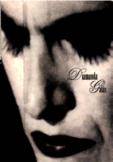 The
fury that Diamanda expresses in her
performances, as for instance we can see in the Plague Mass,
acquires legendary dimensions, which no doubt affect her
emotions, her psyche, her entire body. The actress admits she has
to be strong in what she does, by exercising her technical
discipline, looking after her health, her cardiovascular system,
her diaphragm, her general physical status,so as to be able to
express the powerful emotions that pervade her work, as the
strength she uses to denounce AIDs, mental illnesses or germ
warfare demand such an effort on her part. The fact that she does
what she has to do gives her as much energy as she needs. Her
work is very athletic indeed, which means she has to take care of
her health. Since she cannot tell whether anyone else would be
willing or able to do what she does, she is aware that at her
death her work dies with her. Even if she is aware of her own
mortality, she dislikes talking about this. Once she confessed
that she finds the concept of mortality insulting. She prefers to
be herself the one to determine the moment of her death. She
claims she has planned to have her syringe ready, so that she
will be the one to laugh at death, to laugh at the gods of fate.
And, even if her work may be lost when she dies, she feels uterly
unable to write it down so that others can perform it. She
expects to continue with her own performances for as long as her
body will allow her to, despite all the voices that tell her she
won't be able to continue for many years. She takes it as her
duty and a challenge to look after her body so she can continue
doing what she believes she must do.
The
fury that Diamanda expresses in her
performances, as for instance we can see in the Plague Mass,
acquires legendary dimensions, which no doubt affect her
emotions, her psyche, her entire body. The actress admits she has
to be strong in what she does, by exercising her technical
discipline, looking after her health, her cardiovascular system,
her diaphragm, her general physical status,so as to be able to
express the powerful emotions that pervade her work, as the
strength she uses to denounce AIDs, mental illnesses or germ
warfare demand such an effort on her part. The fact that she does
what she has to do gives her as much energy as she needs. Her
work is very athletic indeed, which means she has to take care of
her health. Since she cannot tell whether anyone else would be
willing or able to do what she does, she is aware that at her
death her work dies with her. Even if she is aware of her own
mortality, she dislikes talking about this. Once she confessed
that she finds the concept of mortality insulting. She prefers to
be herself the one to determine the moment of her death. She
claims she has planned to have her syringe ready, so that she
will be the one to laugh at death, to laugh at the gods of fate.
And, even if her work may be lost when she dies, she feels uterly
unable to write it down so that others can perform it. She
expects to continue with her own performances for as long as her
body will allow her to, despite all the voices that tell her she
won't be able to continue for many years. She takes it as her
duty and a challenge to look after her body so she can continue
doing what she believes she must do.
With respect to her acoustic aspects, Diamanda has worked in the opera world singing for instance, Lady MacBeth; Norma; Tosca; Erwartung, by Schoenberg; as well as other classical works, even if this is not her primary interest. This is why she has never entered the scene of traditional opera. Yet, her special operas, in which she utilizes her voice in an eminently unconventional, innovative way, have been christened by the German critics as "Schrei-Oper" ("Shriek-Operas") as they in a way follow the pattern set by late German expressionist theatre, even if the term that would describe them best would be the one coined by Arnold Schoenberg, that is, "monodramas". The artistic worth of this exceptional woman, even though, as already stated, could well disappear with her at her death, is truly a strong influence in the world of art based on Time. From her most remarkable innovation, in which the artist develops her voice by extending her vocal techniques till they become full monodramas, to her peculiar way of implementing the techniques of sonic collage with her exploration of body ressonance, through new techniques for breathing, the texts of sonic poetry developed in what she herself calls "electroacoustic theatre whose nucleus is the voice of the actor", including the visual elements, always implemented in a shocking way, with her complex lighting games and her shapeshifting colors which emphasize the hallucinating intensity of the sounds she creates, the texts fitting this ensemble, at the same time integrating expressionist as well as symbolist traits, all that will certainly ensure Diamanda Galas and her art an unforgettable post in the history of the scenic arts, with her peculiar tapestry of visual media, theater and sound which tend to the globalization of the Arts into a whole that will not die in the memory of the universe of Artistic Creativity.
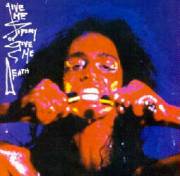 Diamanda
does not believe that her perfomances have a markedly European or
American character, as she perceives herself as a product of both
worlds. Her voice brings us the voice of the dead, the oppressed,
the isolated, the outcast, she awakens us from our lethargy and
forces us to think and react to what she denounces. In the words
of Peter Frank, a music critic for Flash Art,
Galas is a Meta-Musician holding the same
category as Laurie Anderson, Yoko Ono or Brian
Eno, fully capable of undertaking what can be referred
to as the "total overall Work of Art", a work which
will never be a sort of pastiche but one which reflects her
visionary stylization in a wonderful combination of all the
aspects of Art itself. In a few words, Diamanda Galas
is a versatile artist whose art arouses deep passions in the
audience, whose spectacular performances can scandalize to
certain hypocritical sectors of our society, yet she will never
go unnoticed, whether we like it or not.
Diamanda
does not believe that her perfomances have a markedly European or
American character, as she perceives herself as a product of both
worlds. Her voice brings us the voice of the dead, the oppressed,
the isolated, the outcast, she awakens us from our lethargy and
forces us to think and react to what she denounces. In the words
of Peter Frank, a music critic for Flash Art,
Galas is a Meta-Musician holding the same
category as Laurie Anderson, Yoko Ono or Brian
Eno, fully capable of undertaking what can be referred
to as the "total overall Work of Art", a work which
will never be a sort of pastiche but one which reflects her
visionary stylization in a wonderful combination of all the
aspects of Art itself. In a few words, Diamanda Galas
is a versatile artist whose art arouses deep passions in the
audience, whose spectacular performances can scandalize to
certain hypocritical sectors of our society, yet she will never
go unnoticed, whether we like it or not.